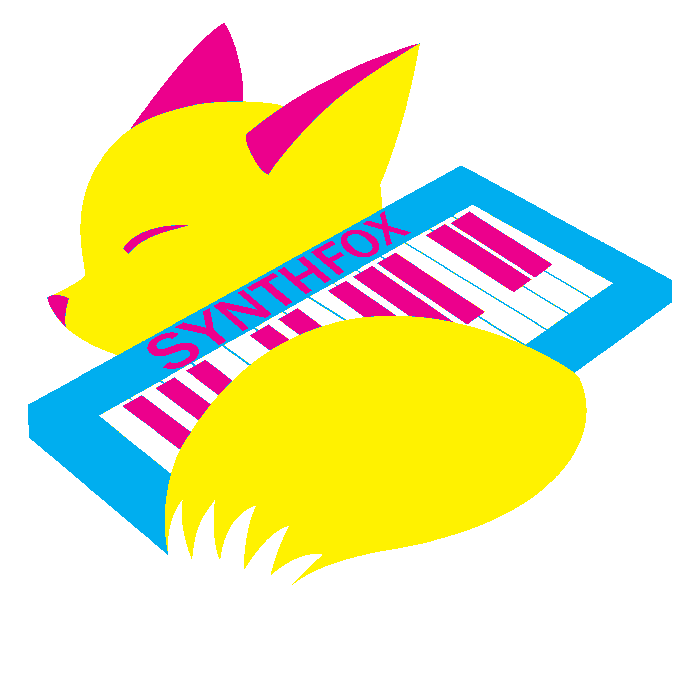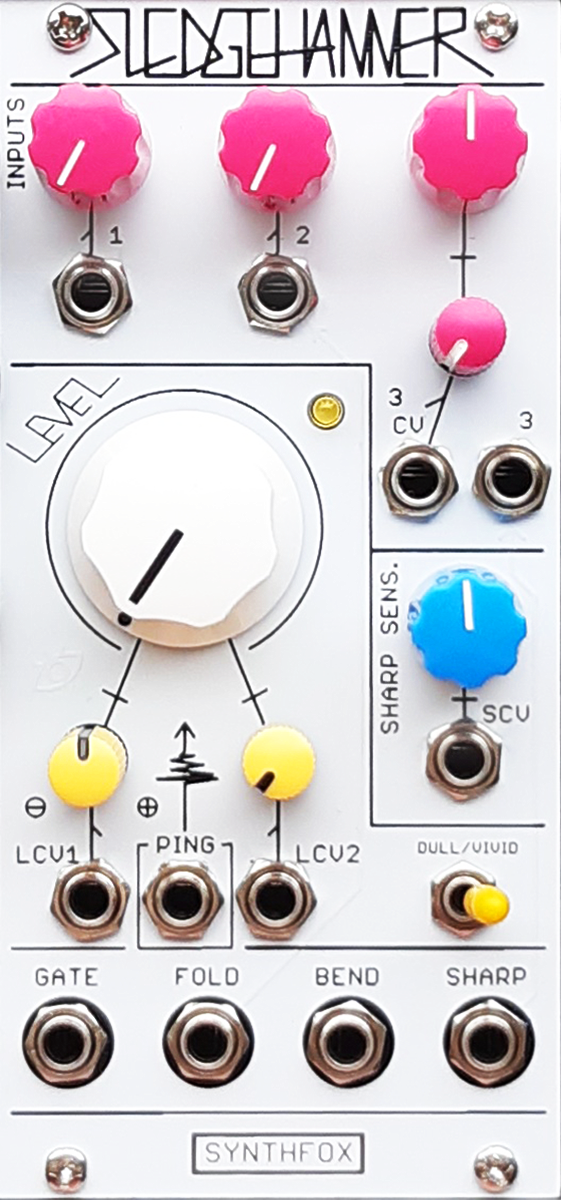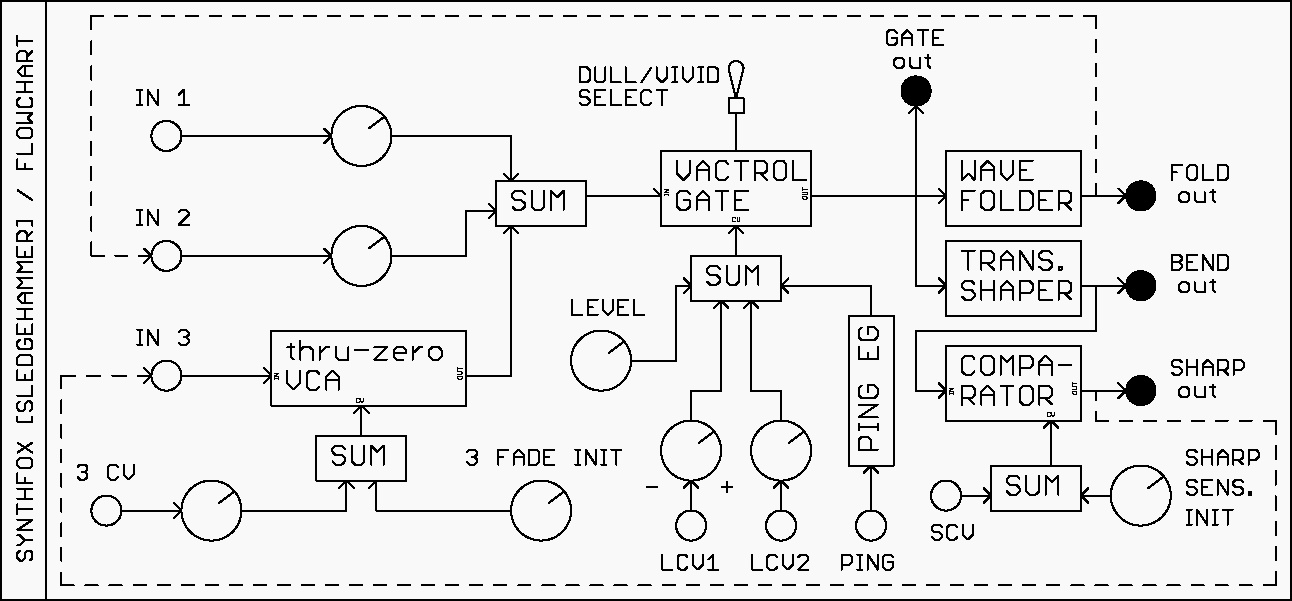SLEDGEHAMMER USER MANUAL


|
Thank you for buying SLEDGEHAMMER by SYNTHFOX. SLEDGEHAMMER is an intricate dynamics/harmonics processor with lots of features, self-patching capabilities and multiple operation modes. In this manual, an overview of SLEDGEHAMMER's features is given, as well as some additional information, such as a flowchart (logic diagram) of the module's insides and some patch ideas. Please, read the safety notice carefully! |
Thank you for buying SLEDGEHAMMER! We at SYNTHFOX want people to have as much fun with and make as much good use out of our gear as possible. But firstly, we want users to be safe and their synthesizer systems to be fully functional. This device is not a consumer piece of electronics. This is a specific part (module) that is to be installed into Eurorack system and interfaced with other parts of it. The user handles the installation process - extra care should be taken!
SLEDGEHAMMER has a keyed connector. The included ribbon cable is tested to comply with standard Eurorack boards, and it cannot be inserted the wrong way into the module. However, the power distribution boards may vary, and it is up to the user to well understand which way to connect the ribbon to the distribution boards. The red line on the ribbon cable marks the -12 volts line. The module should be connected like in the picture below: on the left side is the bus board connector, and on the right side is the connector on SLEDGEHAMMER.

image by David Haillant
When installing the module:
The module should now be ready to play. Have you any troubles, feel free to reach out to SYNTHFOX through synthfoxmodular@gmail.com.

Meet SLEDGEHAMMER, a vactrol gate core experimental dynamics and harmonics processor. This module serves many needs, such as mixdown, wavefolding, waveshaping, distortion, VCA, suboctave generation, and much more. The three signal inputs - one with a dedicated thru-zero VCA, and four differently processed outputs provide endless tonal possibilities and a core module for creative patch-programming.
SLEDGEHAMMER is intended for heavy feedback usage. The INPUTS section mixes down three signals (audio or CV) for further processing. The first and second inputs have dedicated attenuators. The third input is special: it is a voltage controlled crossfader that fades between the negative and positive copy of the input signal. The FOLD output is normalized to input 2, and the SHARP output is normalized to input 3, so patching audio to input 1 and adjusting other inputs' volumes already creates a self-patched feedback loop.
The heart of this module is a vactrol-based dynamics processor ('gate') similar to the widely known low pass gates. It processes the mixdown of the three inputs from the INPUTS section: the big LEVEL knob, two Level CV (LCV) inputs and the PING input control both the amplitude and the slight filtering of the signal: from quiet and dark to loud and bright. The first LCV input has a dedicated attenuverter; the second one has a simple attenuator. The PING input expects a gate, and upon receiving one, will strike the gate with a sharp decay-only envelope. This input has a simple passive circuit behind it, which can be creatively exploited: for example, striking it with stepped voltages, e.g. a S&H output, will make the circuit skip some strikes, and the remaining strikes will have different velocity. The DULL / VIVID switch on the left chooses the type of the response: the DULL setting yields daker, quieter tones, while the BRIGHT setting makes the gate sound more open and loud. Both modes are useful in different applications.
Finally, the output of the gate core is passed through different harmonic processor to create the four SLEDGEHAMMER outputs: GATE, FOLD, BEND and SHARP.
The module has immense feedback capabilities and self-patching possibilities. To ease the process, FOLD output is normaled to Input 2, and SHARP output is normaled to input 3. Just put some audio to Input 1, and a multifeedback circuit is ready to go. But - don't stop just there. Patch and explore!
|
Ⓐ Input 1 and its attenuator (volume control)
Ⓑ Input 2 and its attenuator (volume control)
Ⓒ fade manual control for Input 3
Ⓓ fade CV input and its attenuator
Ⓔ Input 3 jack
Ⓕ Level manual control
Ⓖ Level control voltage 1 input and its attenuverter
Ⓗ Level control voltage 2 input and its attenuator
|
Ⓘ Ping input
Ⓙ Vactrol gate response character select switch
Ⓚ GATE output
Ⓛ FOLD output
Ⓜ BEND output
Ⓝ Sharp output sensitivity manual setting
Ⓞ Sensitivity control voltage input
Ⓟ SHARP output
|

SLEDGEHAMMER is about mixing and feedback: both FOLD and BEND processors are easily overdriven and 'overlapping' signals through them usually results in crazy stuff. A basic multifeedback loop is already set up: FOLD output is normaled to Input 2, and SHARP output is normaled to Input 3. It's always a good idea to mix different sound sources with the three inputs, or set up a more complicated feedback loop through the voltage controllable input (Input 3) using other sound processor modules like filters or delays. The ideas below do not require external modules and are aimed at simpler sounds, like standard waveforms. However, i encourage you to also experiment with more complex sounds and patches!
Set the DULL/VIVID switch to VIVID. Set the potentiometers to default values (like in the image at the beginning of the manual). Patch a sound to Input 1 and bring the volume up to around 3 o'clock. Patch the BEND output to your system's output. Raise the LEVEL knob to noon, and play with Input 3 manual fade and sharp sensitivity - and at some point you will get a loud, screechy peak similar to resonance on filters. Start off from there for even more wicked resonant feedback - and don't forget that Input 3 has a thru-zero VCA on it, so you can voltage control the amount of feedback!
Put a signal (preferably something simple like a triangle or a sinewave) into Input 3. Set the tone switch to DULL. Set the Sharp Sens. manual control to 1 o'clock and put the Sharp output to Input 1. Raise Output 1 volume to about 10 o'clock. Set volume of Input 2 to fully CCW to cut out the FOLD feedback path. Patch the FOLD output to your system's sound output. The module now acts as a gentle wavefolder with peak amount determined by Input 1 volume. The best part is that the processed signal now goes to Input 3 - strike it with envelopes and LFOs for awesome wavefolding effect, and let the LEVEL knob and its LCV inputs control the timbre of the wavefolding instead.
Source signal - again, simpler waves work best - goes to Input 1. Set its volume full CW. Input 2 volume - full CCW, Input 3 manual control to noon. Patch the GATE output to your system's out. Patch the BEND output to Input 3. Raise the LEVEL knob full CW. Now slowly move the Input 3 manual control knob counter-clockwise: the sound starts getting more harmonically rich, then at some point drops out. When it does, very, very carefully go back up: you will start hearing squarewaveish suboctaves building up. When it reaches the tone same as the input, leave the Input 3 manual control like that. Now, turning LEVEL down will make the output go through a few suboctaves!
Put the sourse waveform to Input 1, set the volume somewhere from 3 o'clock to full CW. Cut the second input's volume out. Put Input 3 manual control to noon, LEVEL to noon, Sharp Sens. manual setting to noon, and the tone switch to vivid. Patch the SHARP output to the SCV input. Then, patch the BEND out to your system's output. Slowly turn Input 3 manual control to full CW, then back to noon. Steppy ringing appears, until it becomes a screech at full CW. Going full CCW will cut out the sound. Now use the Input 3 CV to modulate rolling over these steps. This patch works best on higher pitched waves.